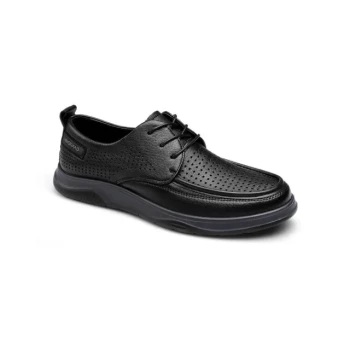The choice between rubber and leather soles hinges on a fundamental trade-off between modern practicality and traditional craftsmanship. A person prefers rubber soles for their superior durability, water resistance, and grip, making them the ideal choice for everyday wear, unpredictable weather, and walking on hard, modern surfaces like concrete and pavement.
While leather soles offer timeless elegance and superior breathability, rubber soles provide unmatched durability and all-weather versatility. The right choice depends entirely on your environment, your lifestyle, and the primary purpose of the footwear.
The Functional Advantages of Rubber Soles
Rubber soles were engineered to solve the practical limitations of traditional leather. Their dominance in modern footwear is a direct result of their functional superiority in several key areas.
Unmatched Durability
Rubber compounds are highly resistant to abrasion. This makes them far better suited for walking on hard, rough surfaces like city sidewalks, where they will significantly outlast a traditional leather sole.
Superior Traction and Safety
Rubber provides a much higher coefficient of friction than leather, especially on smooth or wet surfaces. This natural traction, often enhanced with molded tread patterns, offers stable and secure footing where leather can be notoriously slick.
Excellent Weather Resistance
Unlike leather, rubber is waterproof. This quality not only keeps your feet dry but also protects the integrity of the shoe's construction from moisture damage, preventing warping and rot.
Immediate Comfort and Flexibility
Rubber soles typically require a much shorter break-in period than stiff leather soles. Their natural elasticity provides cushioning and shock absorption, reducing fatigue during long periods of standing or walking.
Understanding the Trade-offs: Rubber vs. Leather
Choosing rubber is not without its compromises. Acknowledging the strengths of leather is critical to making an informed decision.
Breathability and Foot Health
Leather is a natural, porous material that breathes, allowing moisture and heat to escape. Most rubber compounds are not breathable, which can lead to a warmer and more humid environment inside the shoe.
Formality and Aesthetics
A stitched leather sole offers a slim, elegant profile that is the hallmark of traditional, high-quality dress shoes. Rubber soles, while available in many styles, often add more bulk and are generally seen as more casual.
The Molding Process
Over time, a leather sole molds to the unique shape of your foot, creating a personalized and supportive footbed. Rubber is flexible from the start but does not offer this same custom-fit evolution.
Maintenance and Repair
Rubber is exceptionally low-maintenance. In contrast, leather soles require more care and conditioning to prevent them from drying out and cracking. However, high-quality shoes with leather soles are often constructed in a way that makes them easier for a cobbler to resole multiple times.
The Sustainability Factor
Both materials can be sustainable choices depending on their sourcing and production methods.
Natural and Recycled Materials
Both rubber and leather are natural materials that can be biodegradable. High-quality footwear often uses natural rubber or vegetable-tanned leather, which avoids the toxic chemicals used in cheaper tanning processes.
Eco-Friendly Production
Some natural rubber production can sequester carbon from the atmosphere. Furthermore, the use of recycled rubber in shoe soles is a growing practice that helps reduce landfill waste.
Making the Right Choice for Your Footwear
Your final decision should be guided by function and frequency of use.
- If your primary focus is daily commuting or navigating urban environments: Choose rubber for its durability on pavement and reliable grip in all weather conditions.
- If your primary focus is formal business or special events: Leather soles provide the necessary elegance and sleek profile that rubber often cannot match.
- If your primary focus is all-weather versatility and low maintenance: Rubber is the clear winner, providing peace of mind in rain or on varied terrain.
- If your primary focus is traditional craftsmanship and personalized comfort: A high-quality leather sole that molds to your foot is an investment that pays dividends in long-term comfort.
Ultimately, understanding these core differences empowers you to select a sole that truly serves your lifestyle.
Summary Table:
| Feature | Rubber Soles | Leather Soles |
|---|---|---|
| Durability | Excellent on hard surfaces | Wears faster on pavement |
| Traction | Superior grip, especially when wet | Slick on smooth/wet surfaces |
| Water Resistance | Waterproof | Absorbs moisture, can warp |
| Breathability | Less breathable | Naturally breathable |
| Formality | Generally more casual | Sleek, elegant profile |
| Break-in Period | Short to none | Requires breaking in |
As a large-scale manufacturer, 3515 produces a comprehensive range of footwear for distributors, brand owners, and bulk clients. Our production capabilities encompass all types of shoes and boots, including durable rubber-soled footwear designed for modern lifestyles. Let us help you source or create the perfect footwear solution for your market. Contact our team today to discuss your needs!
Related Products
- Durable Rubber-Soled Utility Shoes for Wholesale & Custom Brand Manufacturing
- Wholesale Comfortable Business Casual Shoes Custom Manufacturing
- Safety Footwear Wholesale Manufacturer for Custom OEM/ODM Production
- Wholesale Breathable & Cushioned Training Shoes Custom Factory Production
- Durable Canvas Work Shoes with Rubber Lug Sole | Wholesale Manufacturer
People Also Ask
- What historical breakthrough in 1844 contributed to modern shoe sole manufacturing? The Vulcanization Revolution
- Which type of sole is better for premium sneakers and why? The Definitive Guide to Rubber Outsoles
- Why should we wear rubber soled shoes? Unlock Superior Safety and Durability
- What are the main applications of vulcanized rubber? Unlock Durability for Tires, Footwear & More
- What are rubber soled shoes? The Ultimate Guide to Durable, All-Weather Footwear



















